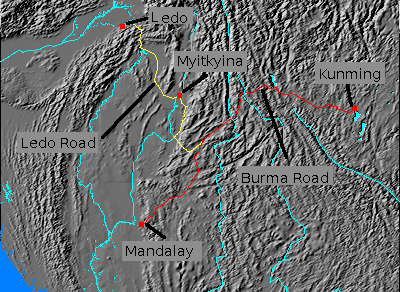![]() The Pacific War Online Encyclopedia
The Pacific War Online Encyclopedia
|
| Previous: Burma | Table of Contents | Next: Burma-Siam Railroad |

The Burma Road was one of the strategic routes
that played an important role in the Second World War. Originally
an ancient road
linking Kunming in China with Mandalay in Burma, it was
rebuilt under the Kuomintang
during 1937-1938 through the efforts of 200,000 conscripted Chinese laborers. It was
an alternate supply route to
China, bypassing the Japanese
naval blockade. At its prewar peak, about 10,000 tons of supplies per month came through the Road.
However, the road had many limitations that made it a serious bottleneck. It was not an all-weather road, limiting its usefulness during the monsoon. It passed through areas in which malaria was endemic. Its status as the last link between China and the outside world made it a focus of intrigue and corruption.
Wastage on the road was considerable: Traffic statistics show less traffic at the start of the Road than on the Chinese border, and only 50% as much traffic arriving at Kunming as crossed the Chinese border. According to one estimate, of each fourteen tons leaving Burma, only five tons arrived at Chungking. The rest simply vanished, most likely diverted by corrupt Chinese officials. Chiang piled agency after agency on the Road in an effort to properly manage it, all under the direction of General Yu Fei-peng, a cousin of the Generalissimo, but in vain. Traffic on the road was about 25% consumer goods, 27% military supplies and metals, and 39% spare parts and gasoline. The latter was apart from what the trucks themselves used. It was estimated that 14,000 tons of gasoline was required to supply 5000 tons at Chungking.
The difficulties were not limited to the Road itself. The rail connection from Mandalay to Lashio passed over the Gokteil Gorge (96.834E 22.354N),
a formidable barrier at which the grade was 1 in 25 for about half the
27-mile (43 km) section. This required trains to be broken into section
and hauled by special climbing locomotives, restricting the flow of
supplies to 550 tons per day. A proposal to build a new Yunnan-Burma
Railroad got as far as shipment of portions of a unused narrow-gauge
line of the Denver and Rio Grande Western Railroad to Burma, but the
plan foundered even before war broke out in the Pacific when estimates
of the construction time crept up to as much as six years.
When war broke out in the Pacific, the Japanese
wasted
little time in invading Burma and cutting the flow of supplies at Rangoon. This left China with
no open ports and no land
connection to the western powers. There remained some routes to Russia, but supplying the Chinese was
almost the last
thing on the Russian’s minds. The U.S. built
large airfields in Assam and used
transport aircraft to
fly supplies into China, but the amounts were never close to sufficient.

Considerable military effort was expended to reopen the Burma Road. As early as 24 January 1942, Lauchlin Currie of the U.S. State Department had proposed construction of a road from India across northern Burma to connect to the Burma Road. In the summer of 1944, Stilwell led Chinese forces from Ledo across the Pangsau Pass into the inhospitable Hukawng Valley. From there his troops advanced to the railroad east of Myitkyina, at Mogaung (96.940E 25.303N), building a new road road behind them. The Japanese were driven out of the Hukawng Valley by 5 March 1944.
The construction of the Ledo Road was carried out by service troops under Raymond Wheeler, who estimated the task would require a force of 10,702 men and nurses.
Once Myitkyna fell, the way was clear for the Chinese forces advancing from northeast India (X Force) to join up with Chinese forces advancing west from Yunnan (Y Force). This allowed the Ledo Road to be connected to the old Burma Road well north of Mandalay. A pipeline was also built alongside the road. The first convoy left Ledo for Kunming on 12 January 1945 and arrived on 4 February 1945. Unfortunately, by this point in the war, the road had become largely irrelevant, as American successes in the Pacific reduced the importance of the China theater.
References
The Pacific War Online Encyclopedia © 2007, 2011-2012, 2014 by Kent G. Budge. Index